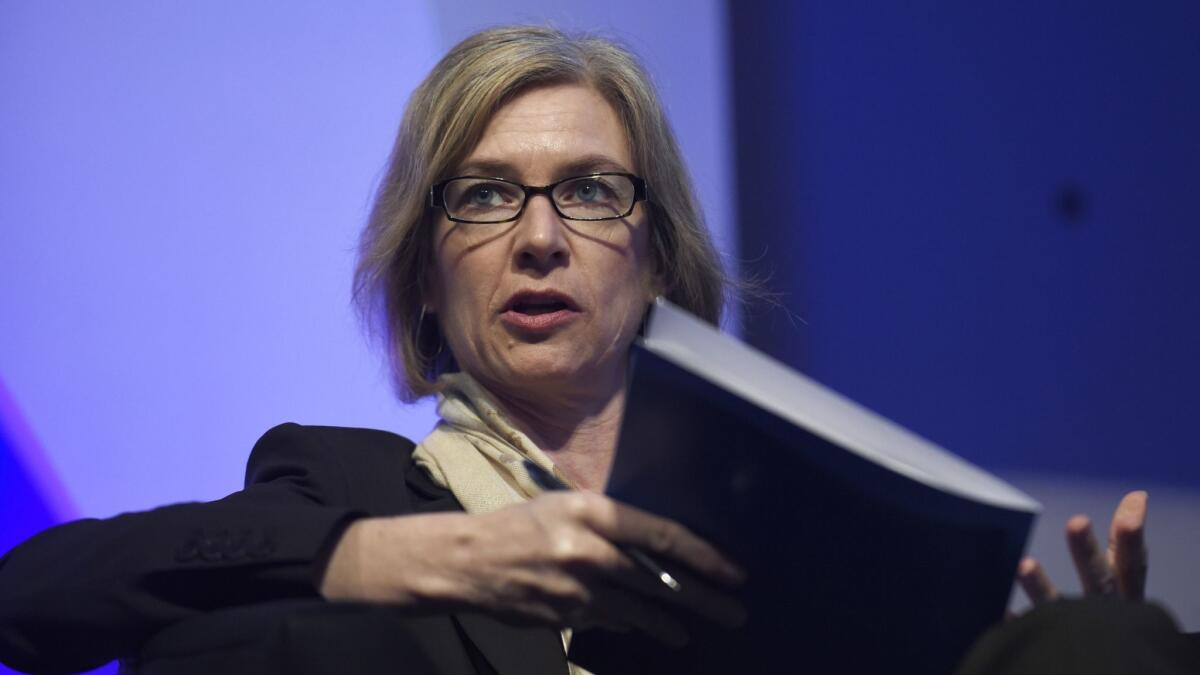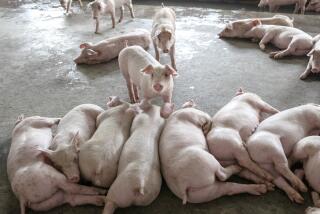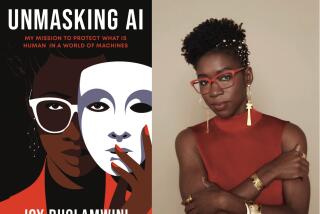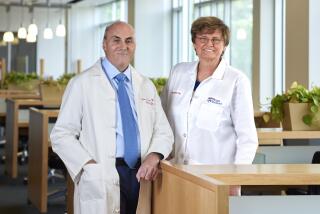Column: CRISPR pioneer Jennifer Doudna struggles with the ethical implications of what she has wrought

Jennifer Doudna faces an uncommon challenge for a scientist at the top of her form and the forefront of her field: While she watches her work produce “breathtaking” advances in the understanding of human biology, she’s struggling with its ethical implications for individuals, for humankind, and for science itself.
Doudna, 53, is one of the most important pioneers in the breakthrough gene-editing technology known as CRISPR. (The term is an acronym for the pattern in DNA strands that forms the basis of the technique.) Working with Emmanuelle Charpentier, now director of Germany’s Max Planck Institute for Infection Biology, Doudna and her lab associates unveiled groundbreaking CRISPR applications five years ago in the journal Science.
By vastly simplifying the cutting and splicing of DNA sequences in the laboratory and in living organisms, CRISPR has revolutionized our understanding of how genes work. It also has reduced the barriers to eliminating mutations that cause disease and introducing others that can change the very physique of living creatures — creating pest-resistant plants, mosquitoes that can’t carry malaria, super-muscular livestock or — within a few years — pigs whose internal organs can be transplanted into human hosts without the risk of rejection.
I’ve mentally prepared myself for the day when I open my inbox or answer my phone, and I realize that somebody’s going to be announcing the first CRISPR baby.
— Jennifer Doudna
“It’s widely available and it’s accessible to people around the globe,” Doudna told me in her office at UC Berkeley one recent morning. “That’s what’s wonderful about it, but also one of the real challenges. How do you control something like that?”
Those two sides of CRISPR are the subject of Doudna’s new book “A Crack in Creation: Gene Editing and the Unthinkable Power to Control Evolution.” Co-written with her former student Samuel H. Sternberg and published last month, “A Crack in Creation” opens with the stark observation that the revolution in gene editing launched by CRISPR “offers both the greatest promise and, arguably, the greatest peril for the future of humanity.”
The first half of the book is a history of CRISPR’s development and a lucid explication of how it works. The authors describe the electrifying atmosphere of a laboratory at the front edge of discovery, while generously distributing credit to the legion of scientists who preceded Doudna and Chapentier or have carried their work forward. That’s notable because the field has been roiled by a battle for credit, presumably driven by the prospects of a Nobel Prize and untold patent-borne riches.
Doudna’s lab, in fact, is engaged in a fierce patent battle with the Harvard- and MIT-affiliated Broad Institute. The book disposes of the patent fight in a single sentence, terming it “disheartening.”
The book’s second half is an examination of CRISPR’s great potential to eliminate or cure disease and improve human existence in myriad ways, and of the perils it poses for humanity’s future. That’s not only if the technology is misused—“perverted,” as the authors put it--but if the new capabilities prove too powerful for humankind to manage wisely.
What sets CRISPR apart from other genomic technologies is the ease with which it allows users to alter DNA not only in somatic cells but germ cells. The former are the cells making up organs; alterations in those cells can’t be passed on to future generations. Germ cells, however, harbor the genetic material that is heritable. Changes in those cells become a permanent part of evolutionary legacies. Obviously, those changes need to be very carefully considered, for once scientists embark down that road, there may be no turning back.
For Doudna, that’s a weighty responsibility. One night in 2014, when CRISPR technology was first becoming widely distributed, she was jolted by a dream in which she was brought to see Adolf Hitler, who asked for an description of “the uses and implications of this amazing technology.” She lay awake, pondering how CRISPR’s “truly incredible power … could be devastating if it fell into the wrong hands,” she recounts in the book.
That came early in Doudna’s philosophical journey through the pros and cons of CRISPR. In January 2015, she helped organize a seminal conference of scientists and bioethicists at a Napa Valley inn “to begin a conversation I felt needed to be happening,” she says. The conference produced a statement signed by Doudna and 17 other participants recommending that “the potential safety and efficacy issues” posed by CRISPR “be thoroughly investigated and understood before any attempts at human engineering are sanctioned, if ever, for clinical testing.”
That sounds like a call for a moratorium on human testing of CRISPR until the nebulous goal of “understanding” is reached. But the term “moratorium” doesn’t appear anywhere in the statement. One reason, Doudna says, is “because that implies some kind of enforcement, and how do you enforce something like that globally?”
The dilemma resembles what scientists faced after the invention of the atomic bomb, but it’s not an encouraging model. As World War II drew to a close, J. Robert Oppenheimer and other physicists campaigned to place nuclear bomb technology under international control. Nothing came of their plea because the United States and Britain were determined to keep the technology for themselves — a forlorn hope, as it turned out. Doudna understands that individual national interests — economic, technological, reputational — might well weigh against a global consensus on limiting CRISPR experimentation.
Doudna eventually came to believe that even the Napa group’s less-than-categorical caution about clinical testing on humans might be too strong. Her meetings with families experiencing genetic disease and her awareness of progress in genetic approaches to cures for conditions such as Huntington’s and Duchenne muscular dystrophy leads her to write in the book: “The stakes are simply too high to exclude the possibility of eventually using germline editing.”
Some reviews of “A Crack in Creation” have expressed disappointment, even resentment, that Doudna did not take an uncompromising stance against human experimentation or editing of the germline. “When it is time to ‘grapple with tricky ethical issues,’” complained Nathaniel Comfort of Johns Hopkins University in Nature, she resorts to “a series of rhetorical questions.”
Doudna responds: “The truth is, I don’t have answers.” Indeed, phrases such as “I don’t know” occur more often in her conversation than one might expect coming from a scientist leading her field. But that’s because so little is still known about CRISPR’s capabilities and the human genome itself that almost all the important questions are rhetorical.
But scientists can’t answer those questions in isolation; the inquiry has to be societywide. There lies another problem underscored by CRISPR.
“There’s a disconnect between the scientific community and mainstream culture, a real degradation in trust by the public,” Doudna says. “Many scientists — I’m guilty of this too — find it much more fun to do the next experiment in the lab than to take the time to explain to nonspecialists what we do or how the scientific process actually works.” The lack of trust, however, will only make it harder for society at large to decide how far it’s willing to push ahead with a revolutionary technology.
Doudna is still searching for hard lines in the sand that CRISPR technology shouldn’t cross. “I struggle with the question of crossing boundaries of speciation that are naturally in place” — raising pigs with human-transplantable organs, for instance. Yet given the persistent shortage of organs for transplants, “You might decide that it would be unethical not to do that.”
She still believes that, given our limited knowledge about the human genome, there shouldn’t be clinical use of CRISPR in the human germ line at present. But the balance is delicate: The same technology that might cure genetic-related conditions such as Alzheimer’s, diabetes and cancer might someday be used to promote desirable, but not life-saving, traits such as intelligence or physical strength, with unpredictable long-term implications.
The only obstacle may be that those generalized traits are dependent on such complex interactions of multiple genes that scientists don’t know how to produce them — yet. “I don’t think that’s going to happen any time very soon, just because we don’t have the knowledge,” Doudna says. “But is it coming in 50 or 100 years?” She pauses to reflect, then says: “Yeah.” And once the knowledge is in hand, pressure from commercial interests and families, especially the wealthy, to use it might be too powerful to resist.
The history of CRISPR, like that of nuclear technology, suggests that in science, what can be done eventually will be done — and a social consensus on whether it should be done comes much later, if at all.
“I’ve mentally prepared myself for the day when I open my inbox or answer my phone,” Doudna says, “and realize that somebody’s going to be announcing the first CRISPR baby.”
Keep up to date with Michael Hiltzik. Follow @hiltzikm on Twitter, see his Facebook page, or email [email protected].
Return to Michael Hiltzik’s blog.







